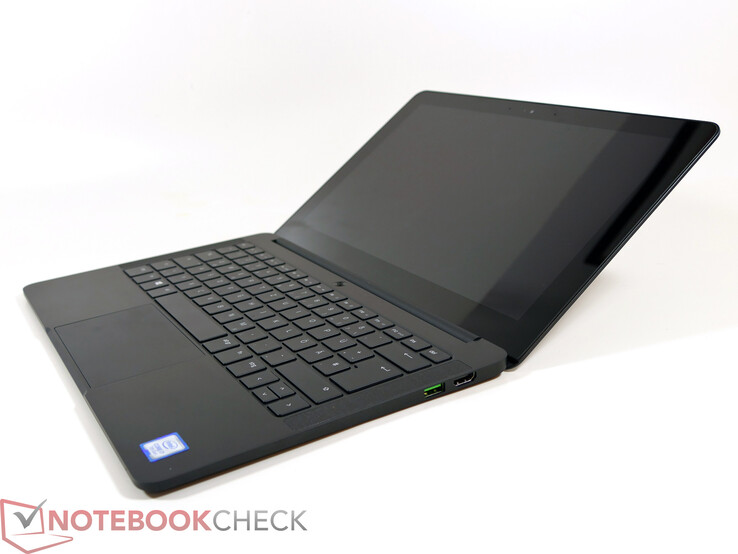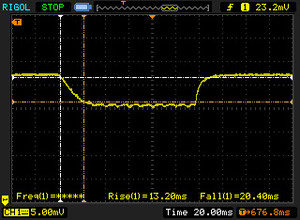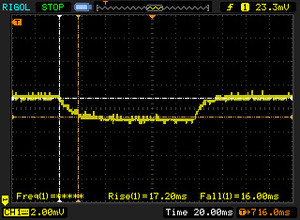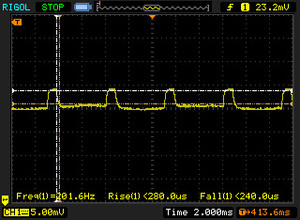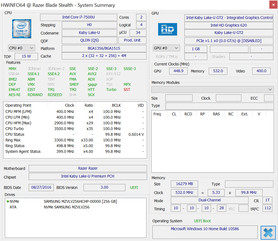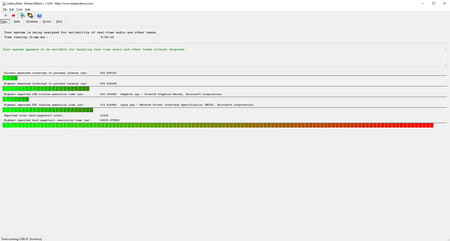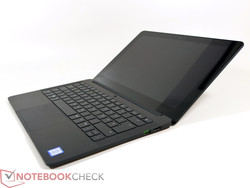Breve Análise do Portátil Razer Blade Stealth (i7-7500U)
Os Top 10
» Os Top 10 Portáteis Multimídia
» Os Top 10 Portáteis de Jogos
» Os Top 10 Portáteis Leves para Jogos
» Os Top 10 Portáteis Acessíveis de Escritório/Empresariais
» Os Top 10 Portáteis Premium de Escritório/Empresariais
» Os Top 10 dos Portáteis Workstation
» Os Top 10 Subportáteis
» Os Top 10 Ultrabooks
» Os Top 10 Conversíveis
» Os Top 10 Tablets
» Os Top 10 Smartphones
» A melhores Telas de Portáteis Analisadas Pela Notebookcheck
» Top 10 dos portáteis abaixo dos 500 Euros da Notebookcheck
» Top 10 dos Portáteis abaixo dos 300 Euros
| Networking | |
| iperf Server (receive) TCP 1 m | |
| Dell XPS 13 2016 9350 (FHD, i7-6560U) | |
| Apple MacBook 12 (Early 2016) 1.1 GHz | |
| Razer Blade Stealth QHD i7-7500U (sim) | |
| Medion Akoya S3409-MD60234 (jseb) | |
| Acer Aspire S 13 S5-371-71QZ | |
| iperf Client (transmit) TCP 1 m | |
| Dell XPS 13 2016 9350 (FHD, i7-6560U) | |
| Medion Akoya S3409-MD60234 (jseb) | |
| Razer Blade Stealth QHD i7-7500U (sim) | |
| Apple MacBook 12 (Early 2016) 1.1 GHz | |
| Acer Aspire S 13 S5-371-71QZ | |
| |||||||||||||||||||||||||
iluminação: 88 %
Contraste: 893:1 (Preto: 0.45 cd/m²)
ΔE ColorChecker Calman: 3.6 | ∀{0.5-29.43 Ø4.78}
ΔE Greyscale Calman: 4.3 | ∀{0.09-98 Ø5}
95.7% sRGB (Argyll 1.6.3 3D)
62.3% AdobeRGB 1998 (Argyll 1.6.3 3D)
69.9% AdobeRGB 1998 (Argyll 3D)
95.8% sRGB (Argyll 3D)
68.7% Display P3 (Argyll 3D)
Gamma: 2.1
CCT: 6572 K
| Razer Blade Stealth QHD i7-7500U 2560x1440, 12.5" | Razer Blade Stealth UHD i7-6500U 3840x2160, 12.5" | Dell XPS 13 9360 QHD+ i5 3200x1800, 13.3" | Lenovo IdeaPad 710S-13ISK 1920x1080, 13.3" | Asus Zenbook UX305UA-FC040T 1920x1080, 13.3" | Acer Aspire S 13 S5-371-71QZ 1920x1080, 13.3" | |
|---|---|---|---|---|---|---|
| Display | 22% | -5% | -1% | -4% | ||
| Display P3 Coverage (%) | 68.7 | 83.7 22% | 64.6 -6% | 66.4 -3% | 65.1 -5% | |
| sRGB Coverage (%) | 95.8 | 99.2 4% | 91.6 -4% | 97.5 2% | 92.8 -3% | |
| AdobeRGB 1998 Coverage (%) | 69.9 | 97.2 39% | 66.5 -5% | 68.4 -2% | 66.3 -5% | |
| Response Times | -43% | 12% | -7% | 24% | -12% | |
| Response Time Grey 50% / Grey 80% * (ms) | 37 ? | 63.2 ? -71% | 31 ? 16% | 52.4 ? -42% | 25 ? 32% | 50 ? -35% |
| Response Time Black / White * (ms) | 33.4 ? | 38 ? -14% | 31.2 ? 7% | 23.6 ? 29% | 28 ? 16% | 29.6 ? 11% |
| PWM Frequency (Hz) | 200 ? | 220 ? | 50 ? | |||
| Screen | 16% | 10% | -13% | -24% | -5% | |
| Brightness middle (cd/m²) | 402 | 415 3% | 444 10% | 344 -14% | 358 -11% | 375 -7% |
| Brightness (cd/m²) | 382 | 399 4% | 393 3% | 326 -15% | 351 -8% | 358 -6% |
| Brightness Distribution (%) | 88 | 93 6% | 82 -7% | 87 -1% | 86 -2% | 87 -1% |
| Black Level * (cd/m²) | 0.45 | 0.309 31% | 0.33 27% | 0.36 20% | 0.4 11% | 0.39 13% |
| Contrast (:1) | 893 | 1343 50% | 1345 51% | 956 7% | 895 0% | 962 8% |
| Colorchecker dE 2000 * | 3.6 | 3.78 -5% | 4 -11% | 6.09 -69% | 5.96 -66% | 4.6 -28% |
| Colorchecker dE 2000 max. * | 7.5 | 7.2 4% | 7.7 -3% | 10 -33% | 10.99 -47% | 8.8 -17% |
| Greyscale dE 2000 * | 4.3 | 3.38 21% | 2.83 34% | 5.36 -25% | 8.93 -108% | 4 7% |
| Gamma | 2.1 105% | 2.23 99% | 2.05 107% | 2.01 109% | 2.28 96% | 2.34 94% |
| CCT | 6572 99% | 7329 89% | 6963 93% | 7230 90% | 6548 99% | 7304 89% |
| Color Space (Percent of AdobeRGB 1998) (%) | 62.3 | 85.1 37% | 59.3 -5% | 62.25 0% | 60 -4% | 57.9 -7% |
| Color Space (Percent of sRGB) (%) | 95.7 | 99.3 4% | 91.4 -4% | 97.54 2% | 93 -3% | 88.7 -7% |
| Média Total (Programa/Configurações) | -2% /
9% | 6% /
7% | -7% /
-10% | -1% /
-14% | -9% /
-6% |
* ... menor é melhor
Exibir tempos de resposta
| ↔ Tempo de resposta preto para branco | ||
|---|---|---|
| 33.4 ms ... ascensão ↗ e queda ↘ combinadas | ↗ 13.2 ms ascensão | |
| ↘ 20.2 ms queda | ||
| A tela mostra taxas de resposta lentas em nossos testes e será insatisfatória para os jogadores. Em comparação, todos os dispositivos testados variam de 0.1 (mínimo) a 240 (máximo) ms. » 90 % de todos os dispositivos são melhores. Isso significa que o tempo de resposta medido é pior que a média de todos os dispositivos testados (20.2 ms). | ||
| ↔ Tempo de resposta 50% cinza a 80% cinza | ||
| 37 ms ... ascensão ↗ e queda ↘ combinadas | ↗ 19 ms ascensão | |
| ↘ 18 ms queda | ||
| A tela mostra taxas de resposta lentas em nossos testes e será insatisfatória para os jogadores. Em comparação, todos os dispositivos testados variam de 0.165 (mínimo) a 636 (máximo) ms. » 52 % de todos os dispositivos são melhores. Isso significa que o tempo de resposta medido é pior que a média de todos os dispositivos testados (31.6 ms). | ||
Cintilação da tela / PWM (modulação por largura de pulso)
| Tela tremeluzindo/PWM detectado | 200 Hz | ≤ 30 % configuração de brilho | |
A luz de fundo da tela pisca em 200 Hz (pior caso, por exemplo, utilizando PWM) Cintilação detectada em uma configuração de brilho de 30 % e abaixo. Não deve haver cintilação ou PWM acima desta configuração de brilho. A frequência de 200 Hz é relativamente baixa, portanto, usuários sensíveis provavelmente notarão cintilação e sentirão fadiga ocular na configuração de brilho indicada e abaixo. [pwm_comparison] Em comparação: 53 % de todos os dispositivos testados não usam PWM para escurecer a tela. Se PWM foi detectado, uma média de 8101 (mínimo: 5 - máximo: 343500) Hz foi medida. | |||
| PCMark 8 - Home Score Accelerated v2 | |
| Lenovo IdeaPad 710S-13ISK | |
| Dell XPS 13 2016 9350 (FHD, i7-6560U) | |
| Acer Aspire S 13 S5-371-71QZ | |
| Razer Blade Stealth QHD i7-7500U | |
| Asus Zenbook UX305UA-FC040T | |
| Medion Akoya S3409-MD60234 | |
| Razer Blade Stealth UHD i7-6500U | |
| Dell XPS 13 9360 QHD+ i5 | |
| Apple MacBook 12 (Early 2016) 1.1 GHz | |
| PCMark 8 Home Score Accelerated v2 | 3362 pontos | |
Ajuda | ||
| Razer Blade Stealth QHD i7-7500U Samsung PM951 NVMe MZVLV256 | Dell XPS 13 2016 9350 (FHD, i7-6560U) Samsung PM951 NVMe MZ-VLV256D | Asus Zenbook UX305UA-FC040T SK Hynix Canvas SC300 512GB M.2 (HFS512G39MND) | Acer Aspire S 13 S5-371-71QZ LiteOn CV1-8B512 | Lenovo IdeaPad 710S-13ISK Samsung PM951 NVMe MZVLV256 | Dell XPS 13 2016 9350 (FHD, i7-6560U) Samsung SSD SM951 512 GB MZHPV512HDGL | |
|---|---|---|---|---|---|---|
| CrystalDiskMark 3.0 | -9% | -27% | -23% | -1% | 115% | |
| Read Seq (MB/s) | 1178 | 1131 -4% | 469.1 -60% | 502 -57% | 1193 1% | 1502 28% |
| Write Seq (MB/s) | 305.4 | 311.4 2% | 412.1 35% | 418.9 37% | 309.6 1% | 1547 407% |
| Read 512 (MB/s) | 638 | 685 7% | 301.6 -53% | 341.3 -47% | 613 -4% | 1020 60% |
| Write 512 (MB/s) | 305.7 | 276.3 -10% | 327.1 7% | 389.7 27% | 311 2% | 1480 384% |
| Read 4k (MB/s) | 38.54 | 39.63 3% | 28.08 -27% | 29.69 -23% | 42.43 10% | 52 35% |
| Write 4k (MB/s) | 153.4 | 133.9 -13% | 71.9 -53% | 86.8 -43% | 144.9 -6% | 139.5 -9% |
| Read 4k QD32 (MB/s) | 614 | 399.7 -35% | 262 -57% | 301.3 -51% | 549 -11% | 467.1 -24% |
| Write 4k QD32 (MB/s) | 302.7 | 245.6 -19% | 274.7 -9% | 211.2 -30% | 311.3 3% | 409.5 35% |
| 3DMark 11 Performance | 1801 pontos | |
| 3DMark Cloud Gate Standard Score | 6538 pontos | |
| 3DMark Fire Strike Score | 918 pontos | |
Ajuda | ||
| baixo | média | alto | ultra | |
|---|---|---|---|---|
| Sims 4 (2014) | 182 | 56.4 | 27.6 | 18.3 |
| The Witcher 3 (2015) | 13.92 | |||
| World of Warships (2015) | 72.9 | 47.78 | 23.63 | |
| Rise of the Tomb Raider (2016) | 20.2 | 12.7 |
Barulho
| Ocioso |
| 31 / 31 / 31 dB |
| Carga |
| 35 / 40.5 dB |
 | ||
30 dB silencioso 40 dB(A) audível 50 dB(A) ruidosamente alto |
||
min: | ||
Razer Blade Stealth QHD i7-7500U análise de áudio
(-) | alto-falantes não muito altos (###valor### dB)
Analysis not possible as maximum curve is missing or too high
(-) A temperatura máxima no lado superior é 46.7 °C / 116 F, em comparação com a média de 34.3 °C / 94 F , variando de 21.2 a 62.5 °C para a classe Office.
(-) A parte inferior aquece até um máximo de 51.3 °C / 124 F, em comparação com a média de 36.8 °C / 98 F
(+) Em uso inativo, a temperatura média para o lado superior é 29.5 °C / 85 F, em comparação com a média do dispositivo de 29.5 °C / ### class_avg_f### F.
(+) Os apoios para as mãos e o touchpad estão atingindo a temperatura máxima da pele (33.4 °C / 92.1 F) e, portanto, não estão quentes.
(-) A temperatura média da área do apoio para as mãos de dispositivos semelhantes foi 27.6 °C / 81.7 F (-5.8 °C / -10.4 F).
Razer Blade Stealth QHD i7-7500U análise de áudio
(±) | o volume do alto-falante é médio, mas bom (###valor### dB)
Graves 100 - 315Hz
(±) | graves reduzidos - em média 8% menor que a mediana
(±) | a linearidade dos graves é média (13.9% delta para a frequência anterior)
Médios 400 - 2.000 Hz
(±) | médios mais altos - em média 5.4% maior que a mediana
(±) | a linearidade dos médios é média (7.5% delta para frequência anterior)
Altos 2 - 16 kHz
(+) | agudos equilibrados - apenas 3.6% longe da mediana
(+) | os máximos são lineares (5.7% delta da frequência anterior)
Geral 100 - 16.000 Hz
(+) | o som geral é linear (14% diferença em relação à mediana)
Comparado com a mesma classe
» 8% de todos os dispositivos testados nesta classe foram melhores, 4% semelhantes, 88% piores
» O melhor teve um delta de 7%, a média foi 21%, o pior foi 53%
Comparado com todos os dispositivos testados
» 16% de todos os dispositivos testados foram melhores, 4% semelhantes, 81% piores
» O melhor teve um delta de 4%, a média foi 24%, o pior foi 134%
Apple MacBook 12 (Early 2016) 1.1 GHz análise de áudio
(+) | os alto-falantes podem tocar relativamente alto (###valor### dB)
Graves 100 - 315Hz
(±) | graves reduzidos - em média 11.3% menor que a mediana
(±) | a linearidade dos graves é média (14.2% delta para a frequência anterior)
Médios 400 - 2.000 Hz
(+) | médios equilibrados - apenas 2.4% longe da mediana
(+) | médios são lineares (5.5% delta para frequência anterior)
Altos 2 - 16 kHz
(+) | agudos equilibrados - apenas 2% longe da mediana
(+) | os máximos são lineares (4.5% delta da frequência anterior)
Geral 100 - 16.000 Hz
(+) | o som geral é linear (10.2% diferença em relação à mediana)
Comparado com a mesma classe
» 7% de todos os dispositivos testados nesta classe foram melhores, 2% semelhantes, 91% piores
» O melhor teve um delta de 5%, a média foi 18%, o pior foi 53%
Comparado com todos os dispositivos testados
» 4% de todos os dispositivos testados foram melhores, 1% semelhantes, 94% piores
» O melhor teve um delta de 4%, a média foi 24%, o pior foi 134%
| desligado | |
| Ocioso | |
| Carga |
|
Key:
min: | |
| Razer Blade Stealth QHD i7-7500U i7-7500U, HD Graphics 620, Samsung PM951 NVMe MZVLV256, , 2560x1440, 12.5" | Razer Blade Stealth UHD i7-6500U 6500U, HD Graphics 520, Samsung PM951 NVMe MZ-VLV256D, IPS IGZO, 3840x2160, 12.5" | Dell XPS 13 9360 QHD+ i5 i5-7200U, HD Graphics 620, Toshiba NVMe THNSN5256GPUK, , 3200x1800, 13.3" | Lenovo IdeaPad 710S-13ISK 6560U, Iris Graphics 540, Samsung PM951 NVMe MZVLV256, IPS, 1920x1080, 13.3" | Asus Zenbook UX305UA-FC040T 6500U, HD Graphics 520, SK Hynix Canvas SC300 512GB M.2 (HFS512G39MND), IPS, 1920x1080, 13.3" | Acer Aspire S 13 S5-371-71QZ 6500U, HD Graphics 520, LiteOn CV1-8B512, IPS, 1920x1080, 13.3" | |
|---|---|---|---|---|---|---|
| Power Consumption | -60% | 18% | 3% | 18% | 10% | |
| Idle Minimum * (Watt) | 4.4 | 9 -105% | 3.7 16% | 3.3 25% | 3.2 27% | 4.1 7% |
| Idle Average * (Watt) | 5.8 | 12.8 -121% | 6.1 -5% | 7.4 -28% | 6.5 -12% | 6.7 -16% |
| Idle Maximum * (Watt) | 8.6 | 16.8 -95% | 6.5 24% | 8.2 5% | 6.7 22% | 7.4 14% |
| Load Average * (Watt) | 35.2 | 35.7 -1% | 29.5 16% | 36.5 -4% | 30.6 13% | 32.4 8% |
| Load Maximum * (Watt) | 52 | 39.3 24% | 33 37% | 43.7 16% | 31 40% | 32.4 38% |
* ... menor é melhor
| Razer Blade Stealth QHD i7-7500U i7-7500U, HD Graphics 620, 53.6 Wh | Razer Blade Stealth UHD i7-6500U 6500U, HD Graphics 520, 45 Wh | Dell XPS 13 9360 QHD+ i5 i5-7200U, HD Graphics 620, 60 Wh | Lenovo IdeaPad 710S-13ISK 6560U, Iris Graphics 540, 46 Wh | Asus Zenbook UX305UA-FC040T 6500U, HD Graphics 520, 56 Wh | Acer Aspire S 13 S5-371-71QZ 6500U, HD Graphics 520, 45 Wh | Medion Akoya S3409-MD60234 i7-7500U, HD Graphics 620, 45 Wh | Dell XPS 13 2016 9350 (FHD, i7-6560U) 6560U, Iris Graphics 540, 56 Wh | |
|---|---|---|---|---|---|---|---|---|
| Duração da bateria | -43% | 17% | -11% | 33% | 5% | -23% | 12% | |
| Reader / Idle (h) | 13.6 | 7.3 -46% | 13.5 -1% | 23.8 75% | 17.1 26% | 12 -12% | 15.7 15% | |
| WiFi v1.3 (h) | 8.3 | 3.8 -54% | 8.8 6% | 7 -16% | 9.4 13% | 7.9 -5% | 4.6 -45% | 7.3 -12% |
| Load (h) | 1.8 | 1.3 -28% | 2.3 28% | 1.5 -17% | 2 11% | 1.7 -6% | 1.6 -11% | 2.4 33% |
| H.264 (h) | 9.1 | 8.1 | 9.1 | 4.1 |
Pro
Contra
Com o seu novo Blade Stealth, a Razer foi capaz de eliminar as desvantagens mais significantes: a medíocre duração da bateria. Com, entre 8 a 13 horas, o novo portátil pode ser utilizado longe das tomadas durante períodos muito mais longos e - dependendo das tarefas - durará o dia todo.
O chassi permanece igual. O design é definitivamente de gama alta e similar ao dos MacBooks da Apple, no que diz respeito à qualidade de construção e sensação táctil. É uma pena que a superfície preta mate seja tão suscetível às digitais, as quais são muito difíceis de remover.
Graças à CPU Kaby Lake e à bateria maior, o Blade Stealth agora consegue competir quando é comparado com outros subportáteis. A eGPU Razer Core é uma opção emocionante, mas mesmo sem ela, o Blade Stealth é um portátil bem-sucedido.
Desta vez o portátil que recebemos estava equipado com um painel QHD+. A tela ganha bons pontos e é quase tão boa quanto a opção 4K. Especialmente quando consideramos o pequeno tamanho de 12,5 polegadas, esta tela, em particular parece ser a melhor opção na maioria dos casos. A configuração com o painel de gama inferior também é 200 Euros (~$220) mais econômica e provavelmente contribui de forma positiva com o (menor) consumo de energia.
Também ficamos impressionados pelo desempenho oferecido. Os resultados do teste da CPU são bastante bons, inclusive quando o sistema está sujeito à carga contínua. O Blade Stealth deve trabalhar muito bem com o Razer Core e deve transformar a combinação em um genuíno sistema de jogos. Mais detalhes virão na seguinte análise
Razer Blade Stealth QHD i7-7500U
- 10/25/2016 v5.1 (old)
J. Simon Leitner




